How Did the 1970s Begin With Fashion and End With Fashion?

The early 1970s fashion scene was very similar to 1969, only a bit more flamboyant. It wouldn't exist hyperbole to say that a fashion revolution occurred in the 1970s.
Polyester was the cloth of choice and brilliant colors were everywhere. Men and women akin were wearing very tight fitting pants and platform shoes. By 1973, most women were wearing high cut boots and low cut pants.
Early on 1970s fashion was a fun era. It culminated some of the best elements of the 60s and perfected and/or exaggerated them. Some of the best clothing produced in the 1970s perfectly blended the mods with the hippies.
Simply when it seemed pants couldn't flare whatsoever more (bell bottoms, anyone?), the flare was almost gone. By the belatedly 1970s the pant accommodate, leisure suit and rails conform was what the average person was sporting. Every woman had a cowl neck sweater in her closet and every human had a few striped v-neck velour shirts.
Tunics, culottes and robes were also very popular. Sometimes it'south hard to tell which dresses were meant to be worn at dwelling, and which ones were for a dark on the town.
Chest hair, medallions, polyester, butterfly collars, bell bottoms, skin-tight t-shirts, sandals, leisure suits, flower patterned dress shirts, sideburns and, yes, lawn tennis headbands.
At that place is one common theme throughout mode in the 1970s: pants were tight fitting. And it is probably the first full decade in which women could exist seen wearing pants in every walk of life.
It'southward likewise hard to miss the fact that color almost completely disappeared past 1979. Earth tones, grays, whites and blacks were back in total forcefulness, as people had evidently tired of the super bright tones of the early 1970s.
QUICK REFERENCE LINKS
1970s Mode Timeline
1970 | 1971 | 1972 | 1973 | 1974 | 1975 | 1976 | 1977 | 1978 | 1979
1970s Style: In-Depth Profiles
1970s Fashion: Pictures
In-Depth 1970s Profiles
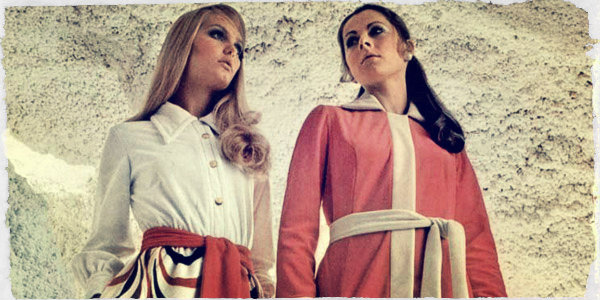
1970s Fashion: Women & Girls »
Women could finally wear whatever they wanted. Compared to previous generations, women'due south fashion in the 1970s was nothing short of revolutionary.
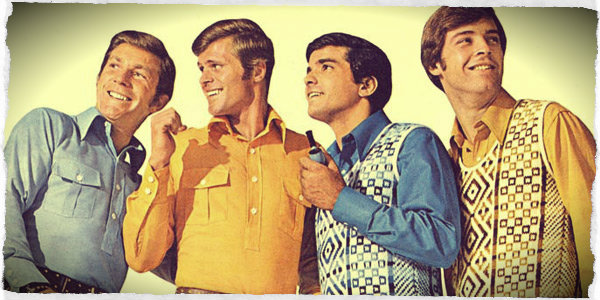
1970s Manner: Men & Boys »
Men'south fashion in the 1970s changed everything. Never before did men have so many choices. Wide flare jeans, platform boots and leisure suits, babe!
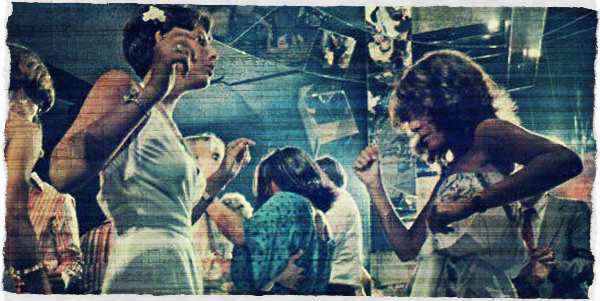
1970s Dresses & Skirts: Styles & Trends »
1970s dresses & skirts could be wildly colorful or sleekly monotone. Designers gave women choices they'd never had. History with 40+ pics of 1970s dresses.
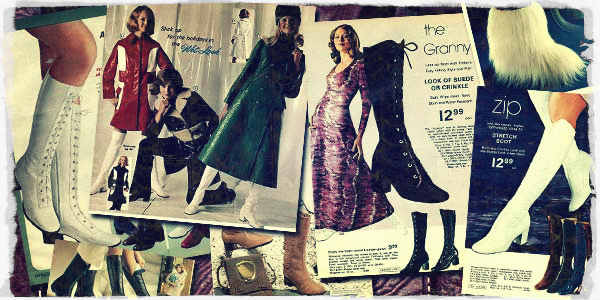
1970s Boots: Styles, Trends & Pictures »
Women's boots in the 1970s saw several manner trends including knee-high, platform, stretch vinyl & patently erstwhile leather. Learn more with over 50 pictures.
Way in 1970
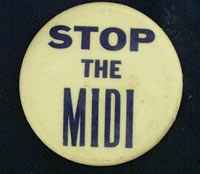
1970 Way: "Finish the Midi" Pin
Hemlines were the headlines in 1970. Across the way industry, designers dropped brim lengths anywhere betwixt the knee and ankle and called information technology the Midi Look or midi skirt. Either you midi'd or y'all didn't.
Mini-skirt lovers picketed New York City shops that carried the new length. After years of building short skirted wardrobes, they weren't about to change now. Others idea the longer skirt aged them. Whatever the reason, the midi skirt was a debacle that sent the fashion industry spiraling downwards.
The midi was slightly different than long skirts from the 1950s. It was slit and slashed, laced-upwards or zipped-up, strapped or wrapped to ane side and sometimes buttoned down the front. It flattered the young and thin nigh, because information technology emphasized a minor midriff, waist and hips. How the leg met the hem was its most critical feature.
Ponchos, gauchos and capes afforded a stylish culling to the midi. Mid-calf length culottes called gaucho pants were the hit of many a autumn style show.
The Moroccan theme was big in 1970. Capes striped like bedspreads, along with folk-embroidered Hungarian peasant blouses gave fashion in 1970 a distinctly ethnic flavor.
Accessories were worn from head to toe. They were most vital part of the new look. Chokers, domestic dog collars and handcrafted cervix ornaments replaced standard jewelry. Some new jewelry embraced natural elements like woods, shells, stones, feathers, Indian beads and leather.
Bags and purses were strapped tightly nether the arm or worn in mailman manner across the chest, much like they were in 2011.
Boots were sold in numbers never before seen. Every type of boot imaginable was sold, in all shapes, sizes and materials.
Pastels and vivid colors were much more than subdued than in 1969. The midi came in somber shades similar imperial, grape, raisin, plum, murky green or indigo. Over again, women didn't similar the midi.
Pecker Blass was elected to the Coty Hall of Fame in 1970.
Fashion in 1971
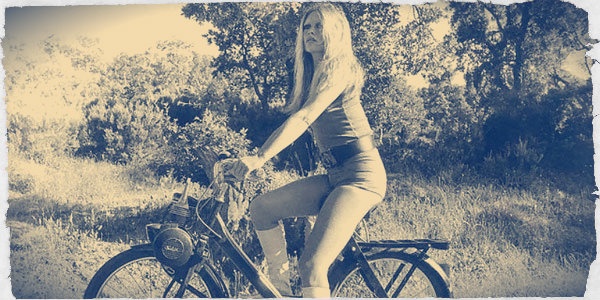
1971 Style: Brigitte Bardot wearing Hot Pants
In 1971 there was a huge impasse betwixt what designers made and what people wanted to wear. It seemed at times the ii were fighting each other like siblings.
Designers declared the hemline would be at the articulatio genus in 1971, but the public had other plans. Skirts that grazed the talocrural joint, that were intended to exist evening gowns, were being worn out on the town. Some other, more than extreme, backlash were "hot pants", which had zilch to do with the and so-called fashion world.
A gustatory modality for nostalgia brought dorsum people'south desire for nautical insignia and 1940s movie star glamour. Another tendency that popped upwardly amongst the wealthy was Chinese-inspired evening gowns.
Sporting a tailored look, young couples liked to dress in similar, if non identical wearable. A quick glance through a 1971 itemize backs this up, for it is difficult to miss the endless pages of his & hers matching sets.
Yves Saint Laurent instigated the 1940s revival in his bound Paris drove that was widely panned past critics simply embraced past young trendsetters.
Men's fashion started to shed the flamboyant styles of recent years, but they retained a sense of fun and freedom. Clothes were snugly fit, tailored and double knit. Plaid was a pop choice for a mean solar day at the function or on the farm and pants remained flared.
The fashion world was saddened past the passing of legendary designer, Gabrielle Bonheur Chanel, better known as "Coco," at historic period 87. Her rigorous discipline to the very end helped her maintain an unheard of 50+ years of relevancy and influence on the fashion world. She remains to this twenty-four hours 1 of the most of import manner designers in history.
Fashion in 1972
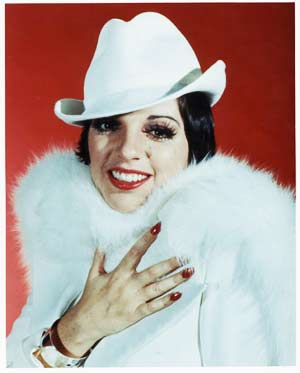
Liza Minnelli wearing Halston (1972)
Fashion relaxed a bit in 1972, worrying less about hemlines and waistlines, shifting into the casual mood of sportswear for both daytime and evening styles.
According to designers, the busy modernistic woman wanted to look at ease, uncontrived, and certainly never obvious afterwards years of self-consciousness. An important aspect of being stylish in 1972 was non to look as if one had spent either too much time or coin on clothes.
The sweater was a pivotal point of this effortless effect. It was the year's most important way ingredient, cropping up every bit a beach cover-up, the basis of urban center costumes, the bodice of haute-couture satin evening gowns.
Subsequently sweaters, a woman could cull between long or short dresses, skirts or pants, belted waists or no waists, bare halters or covered-up caftans. Such designers as Yves Saint Laurent showed most of their daytime styles at mid-knee level, but they included several mid-calf and ankle-length skirts.
Female delegates at the Democratic National Convention in Miami illustrated the variety of attire bachelor to the American adult female. They turned up in everything from floor-length dresses to faded blueish jeans. Critics blamed designers for failing to provide fashion management. Actually, the wide range of choices represented the toll-conscious consumer'south triumph over the couturier.
The most successful designer of 1972 was Halston. His clothes, whisked up by such way leaders as Liza Minnelli and Jackie O, were elegant versions of established American classics — shirtwaist dresses, cashmere pullovers and cardigans, wrapped jackets and pants. So big was the influence of the unstudied, sportive American shapes on what women around the world wore in 1972, that experts claimed New York City, rather than Paris, was the manner uppercase of the world.
The ease-is-of-the-essence fashion philosophy affected the way a garment met the torso. After a decade of drawing wearing apparel closer to the figure, designers began to let go. Snug-bodiced fashions were rivaled by a revival of the chemise, the blouson, caftans, smocks, tents, toppers, battle jackets, and baggier sweaters.
Elasticized and drawstring waistlines, shirred yokes, deeper armholes, and dolman, raglan, and kimono sleeves helped ease silhouettes.
Jeans were very much in way in 1972 for both men and women.
Textures softened into cashmere, shetland, angora, lambswool, mohair, brushed-wool plaids, cuddly, lamblike acrylic piles, fluffy, long-haired furs.
Hushed hues and pastels served as further softening agents. Mauve, peach, apple-green, pink, yellow, and baby-blue tended to exist used in all-of-a-tone costumes, such as a pink-shirt with a pinkish-striped sweater over a pink plaid skirt.
Natural and neutral shades of white, wheat, camel, and grayness melted into one another in luxurious fabrics or connected sporty separates of nonchalance.
Accessories underlined the monotone scheme. Amidst the favorites were tortoise, ivory, bister, pewter, silver, braided-leather cubes, buttons strung together, whale and tiger teeth. But pearls were the most popular embellishment for ears, necklines, and wrists.
Brimmed cloche hats replaced knitted caps, niggling flat envelopes tried to oust the always-present shoulder numberless. Clogs, wedgies, cork-soled platforms, and chunky, high heels continued to alert podiatrists. There was a trend toward shorter pilus styles for both men and women.
Men's Fashions were dominated by the gentlemanly ideal, as the wild prints and fancy sartorial treatments of recent years gave style to traditionally masculine materials and shapes. Assuming plaids livened upwardly sport jackets; rich, modulated tones in houndstooth checks, Donegal tweeds, and Prince-of-Wales plaids were used for business suits. Summertime-weights revived such favorites as crinkly seersucker, khaki, and all-white Mark Twain-type "ice cream suits."
Other comebacks: beefy sweaters with more texture in shetland, mohair, Norwegian-type knit; and hefty woolens cutting into stalwart stormcoats, battle jackets, peacoats, and lumberjack shirts. The buttoned-down shirt returned in 1972 with a more generously proportioned collar.
Ties turned to smaller, timeless motifs: stirrups, anchors, paisleys. The ii-button, waist-and-shoulder-expressed construction reigned for jackets, but there was a drift dorsum to pleated pants and boxy, raglan-sleeved coats with simply-below-the-knee hems.
Men's footwear became more flamboyant. Men wore shoes with wild colors as thick platforms and three-inch heels became popular with immature and old akin.
Manner in 1973
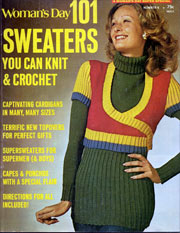
1973 Mode: Sweaters
The key to fashion in 1973 was the knitting needle, as the sweater became the popular look on both sides of the ocean.
There were sweater coats, sweater dresses and even sweater suits. Many of them were trimmed with fur, especially fob. Floor-length sweaters came with or without sparkle. The chunky, shawl-collared, belted cardigan, often in brownish and white, replaced 1972'due south shrink tops.
The new sentiment amidst designers was that the outfits had to piece of work harder and longer and to exist able to change with unproblematic addition of a shirt, pants or accessory.
For the first time in decades, there was a significant shortage of raw materials and fabrics. The toll of synthetics such as vinyl and nylon rose as well. As a result, everyday designers kept things unproblematic.
Pop fabrics & patterns in 1973 were tweeds, flannels, plaids, checks and stripes. Rust, peach, tangerine, copper, forest green, pistachio were pop colors.
Accessories were subdued. Golden chains, aureate-button earrings and rhinestone clips were finding their way back into the wild afterward having been stashed abroad in favor of bootleg jewelry for a few years.
Perhaps the biggest alter in women'due south style in 1973 wasn't an article of vesture at all: it was her hair. A shorter, polished, shoulder-length page male child or a close crop with upturned bangs framing face were the hairstyles of the new. Shorter hair prompted a telephone call for hats. A chic evening choice was the niggling black veiled hat, often accompanied past boas in fur or feathers.
Men's fashion was amusing over aggressive. The trend leaned toward the inconspicuous and comfortable. Neutral colors and standard fabrics made up the majority of new men's wear. A new fad — piping — showed up on blazers and suits. Pea jackets, baseball jackets and varsity jackets were the common human being's selection on an active fall day.
Oscar de la Renta was inducted in the Coty Hall of Fame in 1973.
Fashion in 1974
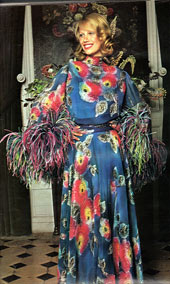 In 1974, fashion designers tried to change tight fitting, body hugging wearable styles into something a bit looser. Like, a lot looser.
In 1974, fashion designers tried to change tight fitting, body hugging wearable styles into something a bit looser. Like, a lot looser.
The silhouette in 1974 was significantly unlike in this way. The Big Await (or The Droop, depending on your view), designers hoped, would sending customers dorsum to the stores specifically for dresses.
After the midi skirt disaster, fashion designers were desperate for some good news. Many shops had shut due to poor sales, made worse by an ongoing recession.
Frankly, people were finding their trusty sweater, t-shirt and pair of jeans and they wore them nigh every day. This did not assistance the fashion industry prosper.
In fact, the t-shirt, in one case considered underwear only, was now being blazoned with slogans, sports teams and annihilation else you could imagine, making it one of the hottest fashion items worn by casual men and women alike.
Typical of The Big Look was a circular greatcoat, tossed over a bulky sweater and shirt hanging effectually the knee joint. Coats were full and tentlike. Standouts were the steamer coat, raglan-sleeved, besides as cardigans or kimonos of dressing gown proportions with yokes, smockings and drop-shoulders.
Berets, muffling scarves and high-heeled, baggily crushed boots were essential in 1974. Leather belts, slender cervix chains, delicate rhinestone ropes, lace-edged chiffon kerchiefs, silk flowers all proved to be worthy ornaments.
The wavering line between sportswear and tailored suits blurred further with the introduction of the leisure conform. While they were intended for the country, they appeared everywhere — just brusk of the office. Men still loved their flannel.
Geoffrey Beene and Halston were elected to the Coty Hall of Fame in 1974.
Fashion in 1975
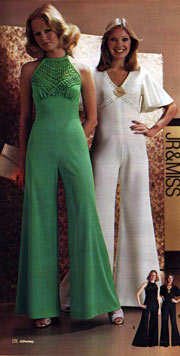
1975 Mode: Bound Suits
Fashion in 1975 touched on everything from loose peasant garments to tailored blazer suits. Many of these outfits were fabricated from quality fabrics like Harris tweed, wool flannel, cashmere, camel'southward hair, pure cotton and pure silk.
1975 manner was non a time for major upheavals. New shapes leaned toward the torso and their fullness was tamed. Calvin Klein's reefer coats and Yves Saint Laurent's tube dresses were in loftier demand.
Designers such equally Geoffrey Beene also softened bulk by wrapping the waist and balancing smock-like shirts with slim skirts and directly-leg pants.
Skirts sported dressmaker details such as yokes, tucks, pleats, smocking, dirndl gathers, wraps, cargo pockets or ropes.
Layering added a rich wait in 1975. Double blouses, multiple sweaters, pants under tunic dresses, jumpers over dresses, hoods under hats and shawls over everything. The triangular scarf was the ultimate layer.
Denim, the familiar blue-jeans cloth, moved into fashion respectability as young and one-time alike flocked to wear it in a variety of ways.
Erstwhile clothes, meticulously made of castoff finery, one time the special domain of eccentrics, became the rage. Young people flocked to antique shops swooping up hand-me-downwards evening bags. Art Deco jewelry, smudgy-pinkish georgette dresses and the wispy undergarments of the 1930s.
A craze for khaki, olive-drab and workmen's clothes threatened to knock out jeans and t-shirts equally America's favorite uniform.
The jumpsuit was a huge success in 1975. It came in hard-working fabrics like twill, drill, duck, baby-wale corduroy and seersucker. Uniform components included parachute pants, painter's pants, clam-diggers, culottes, butcher apron wraps, military fatigues pushed into gainsay boots, naval-inspired dresses and a whole battalion of epaulets, aught-upwards pockets and webbing belts.
Menswear came closer to translating the high European tailoring tradition into comfortable clothes. the so-chosen American accommodate was farther modified to resemble the closer plumbing equipment European model. The new look, called the quasi-European conform, had slightly padded shoulders, higher arm holes, a more prominent waist suppression, open up patch pockets and a light flare to both jacket and pants.
Geoffrey Beene received a Coty Award and Calvin Klein and Piero Dmitri were elected to the Hall of Fame.
Fashion in 1976
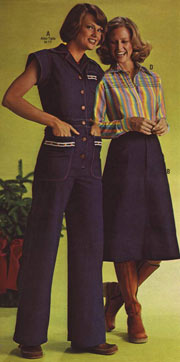 In 1976, the manner split into ii very different directions. One was the Parisian peasant way, which used capes, turbans, rich fabrics, glowing colors, billowing skirts and puffy sleeves.
In 1976, the manner split into ii very different directions. One was the Parisian peasant way, which used capes, turbans, rich fabrics, glowing colors, billowing skirts and puffy sleeves.
The other was the groomed All-American look that borrowed stylings from classic sportswear.
The professional person uniform of the year was a blazer, cowl-neck sweater and slimmed-down skirt. Neb Blass, Calvin Klein and Ralph Lauren all used tweeds, plaids, corduroys and flannels in tans, grays, browns and muted greens.
Pinstriped pant suits with bow-tied blouses became women'southward tuxedos at dark. Pants were cuffed to blouse at the ankles, mid-calf or knees, depending on the tiptop of the boot.
Braving the 1976 wilderness were woolly lumberjack shirts, hunter's red jackets, trapper's down-filled coats and earth-toned ponchos.
Menswear enjoyed unprecedented freedom every bit designers mixed styles, textures and colors like never before. The belong became more relevant over again.
It wasn't uncommon to see a man at the office wearing a plaid jacket, a checkered vest and solid flannel pants.
Velvet jackets, cut like tuxedos, were worn over casual pants, giving a note of elegant informality for more formal evenings.
Fashion in 1977
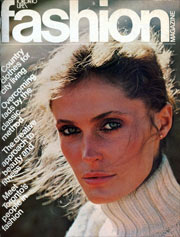
1977 Fashion Magazine Cover (Autumn)
In 1977, fashion took on a softer, looser mental attitude. Designers let clothes fall where they savage and instead chose to twist, tie and gather fabrics instead.
The importance of the soft cloth in 1977 cannot be understated. In wintertime, nigh all article of clothing was made of sensuous fibers such as chenille, challis, chamois, cashmere and mohair.
The baggy style wasn't popular with everyone. Women with good figures lamented not being able to show them off while those who were slightly heavier complained that loose clothes made them expect even bigger.
That didn't finish pattern houses from running with the mode, withal. Gianni Versace and Giorgio Armani brought glamour and attention back to Italy with loftier fashion success. Just the near habiliment of the new fashions came from Calvin Klein and Nib Blass, whose drawstring tops perfectly complemented a full dirndl skirt.
Assuming gold, shiny satin and bareness of skin fabricated up for the lack of body hugging wearable. Shirts were left unbuttoned, sleeves were rolled upwardly and tops were oft lacy, come across-through and strapless.
The scarf was the accessory of the year, only it was non used to cover the hair. People let their hair grow naturally — tousled, curly, frizzy or straight. Women would adorn their heads with colorful flowers or golden combs.
Men'south shirts had smaller collars in 1977 and quilted-down ski vests were worn over almost anything, anywhere. It was fashionable to spike but the lowest push button on a double-breasted conform.
Ralph Lauren was elected to the Coty Hall of Fame in 1977.
Fashion in 1978
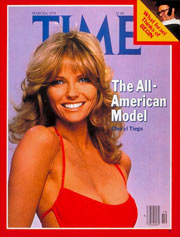
1978 Fashion: Time Magazine Cover with Cheryl Tiegs
Style took a dramatic turn midway through 1978. The casually loose, costless-flowing silhouettes suddenly trimmed downwards. The tearing abroad of book meant a clearer definition of the figure.
Wide shoulders loomed in a higher place belted waists, hip-rounding skirts and pegged pants. The shape was that of an upside-downward triangle. Shoulder pads were resurrected equally were the tailored suits and tilted hats of the 1940s. Sultry black worn with elaborately rolled upswept hairdos, silvery-fox boas, braceleted gloves and spike-heeled sandals summed upwardly the mood of nostalgic glamour.
The "Retro Look" was best pulled off with a touch of humour by immature people dressed for disco dancing.
Also revived in 1978 were strapless tops, bust darts, midriff seams, cummerbunds, waist cinchers, obi wraps as designers zoomed in on the torso.
Many retailers were cool on the new curvier wearing apparel, but the fashion industry was convinced that the narrow, sensuous silhouette was the adjacent direction because of womens' renewed interest in practise.
In Italy, Giorgio Armani and Gianni Versace sent models marching down runways in militaristic, bold-shouldered outfits of leather and khaki. The fervent customer acceptance of pencil-slim separates by Perry Ellis and Calvin Klein pointed the way dorsum to the trunk.
A new selection of handsome coats included reefers, reversibles and three-quarter or seven-eights length garments tailored in melton, alpaca and tweed.
Textures were mixed with reckless abandon — the more the merrier. Several neutral shades were jolted with an electric streak of colour. Golden chiffons, whipser-weight lames, sequins and bugle beads added dazzle.
The feeling was more than relaxed for men. Tweeds dominated suits, jackets and coats. The raglan-sleeve glaze gained new adherence as opposed to the fitted glaze. Trousers were much less flared than earlier and in some cases non flared at all. Lapels, ties and shirt collars narrowed. The single nigh important men'south accessory was the scarf worn outside the jacket.
Fashion in 1979
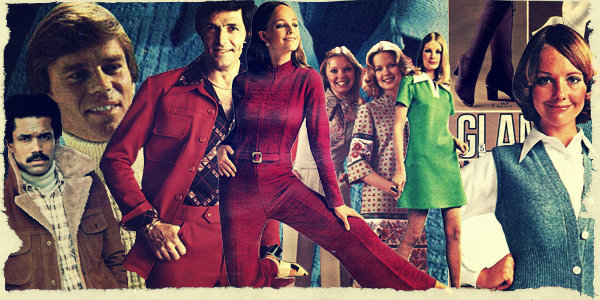 In 1979 the tailored adapt dominated daytime and evening wear. Quickly vanished had the days of casual sportswear, which had been so popular throughout the 1970s. People were tired of the coincidental await and had gotten back into businesswear. Past 1979, fashion that was known as "seventies" mode had fully transformed into what people at present would think of equally eighties way. Equally the eighties approached, the fashion world seemed to have gotten a head get-go.
In 1979 the tailored adapt dominated daytime and evening wear. Quickly vanished had the days of casual sportswear, which had been so popular throughout the 1970s. People were tired of the coincidental await and had gotten back into businesswear. Past 1979, fashion that was known as "seventies" mode had fully transformed into what people at present would think of equally eighties way. Equally the eighties approached, the fashion world seemed to have gotten a head get-go.
With an increased emphasis on formality, blazers and pants skirts became much more easily mixed and matched. The trend of heavily padded shoulders first hit the scene in 1978, which borrowed and somewhat exaggerated the 1940s await, had surged more visibly into the mainstream in 1979.
The eccentricity that highlighted early 1979 gave manner to a more powerful and respectable look past fall.
Style designers had to promptly react to the fact that there were an unprecedented number of women in the workforce. Design houses had gotten used to spending the bulk of their time creating wearable for women who were at home or at parties, not in the office. But times were certainly changing and the most successful designers saw this opportunity for a new market, they adjusted, and capitalized.
The Executive Woman owned at least 1 tailored adapt. The jacket could be either brusque and shapely or long and lean. The straight skirt was knee-length and could possibly accept a forepart or side slit that put a subtle emphasis on the legs. To offset the more traditionally masculine look of "business adjust style", women were experimenting with hats, high heels, ruffles that peaked out from the jacket and large jewelry to go along a confident, notwithstanding feminine, look in tact.
Beyond the arrange, the novelty sweater was the second most of import item in a 1979 wardrobe. Thick, hand-knit styles popularized past Perry Ellis, Geoffrey Beene and Ralph Lauren were flying off the shelves. Sweaters were decorated with a wide array of sequins, ribbon trims and other designs, sometimes asymmetrical, to modernize the expect of classic angora, alpaca, wool and cashmere. Women's sweaters often had metallic thread woven into natural yarns.
The most popular color combinations in 1979 were red and black, black and white, and white and cerise. Deep night grays (think charcoal) were also popular, as were earth tones in about any combination you can imagine. If a splash of color was desired, some derivative of regal was usually the preferred choice.
For men, Giorgio Armani was hailed equally the most creative new designer. He displayed courage when trying out bold new colors that had non been seen in menswear in years, if ever.
Concrete fitness was important to the general public in 1979, and thus dictated trimmer waists, slimmer suits and smaller shirt collars and ties. In the southward, mid-west and west, the "Western Await" was yet going strong. Flannel shirts sold extremely well.
Halston and Calvin Klein created a stir by refusing to have their Coty Awards. Mary McFadden was inducted into the Hall of Fame. Special awards were given to Barry Kieselstein-Cord for jewelry, to Gil Truedsson for men's shoes and Conrad Bong for men's furs.
Women'south Fashion Pictures, 1970-1974
CLICK IMAGE TO ENLARGE
Women's Manner Pictures, 1975-1979
CLICK Image TO Overstate
Men's Fashion Pictures, 1970-1974
CLICK Prototype TO Overstate
Men'due south Fashion Pictures, 1975-1979
CLICK Image TO ENLARGE
0 Response to "How Did the 1970s Begin With Fashion and End With Fashion?"
Post a Comment